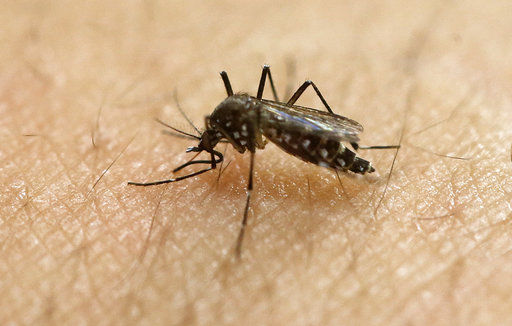Three cases of the West Nile virus have been confirmed in Hidalgo County, officials announced Monday.
The cases include two Mercedes residents and one Weslaco resident, Hidalgo County Health and Human Services Director Eduardo Olivarez said in a virtual news conference.
The last time the virus was detected in the county was in 2018, Olivarez said.
West Nile is most commonly spread to people by a bite of an infected mosquito; it’s the leading mosquito-borne disease in the U.S., according to the Centers for Disease Control and Prevention. There are no vaccines or medicines to treat the virus, and most people infected with it never show symptoms.
The CDC estimates that every one in five people who have contracted the virus are at risk of developing West Nile fever. Additional symptoms of the virus include headaches, body aches, body stiffness, specifically in the back and neck area — similar to signs of COVID-19.
Olivarez said the pandemic will make it difficult to identify more West Nile infections, since both viruses share the same flu-like symptoms. He noted one local individual who was infected with West Nile initially got tested for COVID-19. After testing negative, the person’s physician had the foresight to test for mosquito-borne illnesses.
The West Nile virus is spread by the Culex species of mosquito — a species Olivarez said is very common in the Rio Grande Valley.
He said the county’s vector control task force is working alongside city commissioners and leaders to investigate whether the cases are travel-related. The county will also begin spraying streets.
Spraying vehicles, Olivarez said, are deployed in the wee hours to avoid traffic and catch mosquitoes at the time they are most active. Since the spray must come in contact with the mosquito to kill it, spraying can only be done when the wind is blowing at less than 10 mph and humidity is less than 80%.
However, Olivarez said a majority of the effort to mitigate West Nile is up to the community.
“I want to be real upfront with everybody, 80% of our mosquito prevention can be done by our residents,” he said. “Our residents can actually handle that a lot better than the counties or cities can.”
Some preventative measures to guard against the West Nile virus include getting rid of any standing water that could be sitting in yards, in items such as tires, buckets, planters and toys. Residents are also encouraged to apply repellent and wear long sleeves and pants when going outdoors. For infants and babies whose skin may be sensitive to regular mosquito repellants, alternative natural eucalyptus-based oils are recommended.
Olivarez also advised residents to limit outdoor activities from dust to dawn.
“The No. 1 way to prevent this is to not get stung by mosquitoes, but that is very difficult in the Rio Grande Valley, especially with this nicer weather we’re having,” Olivarez said.
Though mosquito season typically peaks in the summer for most of the nation, Olivarez said most mosquito-borne illnesses in the Valley are contracted in November and December.
And though there is no vaccine for humans, there is one for horses. Olivarez emphasized the importance of having ranchers vaccinate their horses, mules and donkeys for West Nile.
There are currently 48 confirmed cases and eight deaths of the West Nile virus in Texas this year, not including Hidalgo County’s three recent cases.
Though in most cases the virus is never detected or results in mild symptoms, it can be life-threatening. According to the CDC, one in every 150 people with the virus have their central nervous systems infected, putting them at risk for several neurological disorders.
There were a couple of West Nile virus cases in the county in 2018, Olivarez said, and several in 2014-15, one of which resulted in a death. Several locals were also paralyzed due to the West Nile virus several years ago.
Additionally, unlike COVID-19, the West Nile virus can not be passed between people — it can only be contracted from mosquito bites.
Olivarez added it is possible for individuals to be infected with West Nile, COVID-19 and the flu at the same time. There are currently around 28 people in the county who are fighting both COVID-19 and the flu.
“It is possible to have West Nile and have one of the other illnesses, sure it is. It is possible, highly unlikely, but possible,” he said.
Though preventative measures will lower the risks of more residents contracting West Nile, Olivarez said he is expecting more cases, as is usually the pattern when two or three cases arise.
“I do expect to see more cases. Now, how many? Who knows,” he said.
Editor’s note: This story was updated with the full version that appeared in the Oct. 20 print edition.




